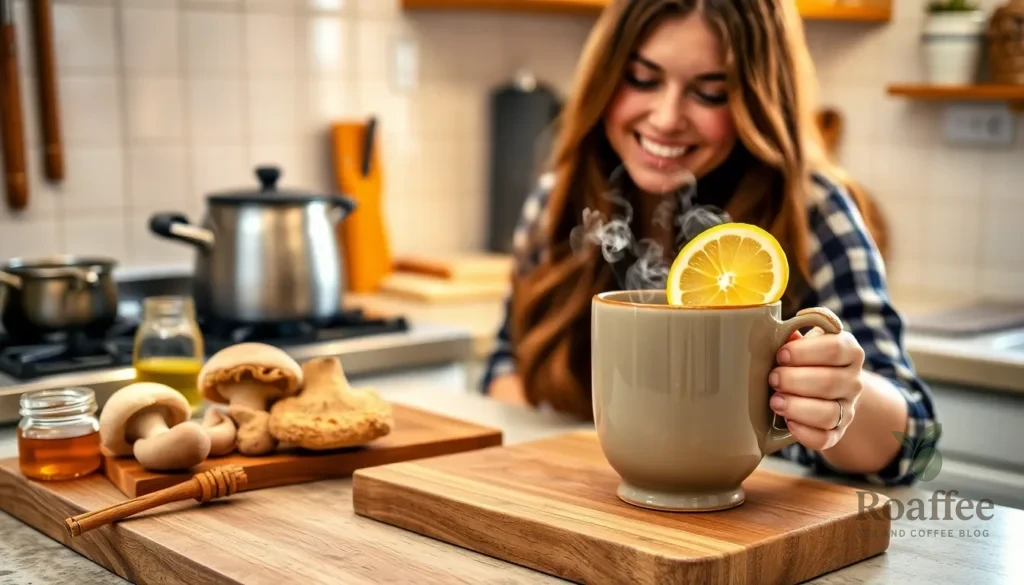We’ve discovered that mushroom tea is one of nature’s most underrated wellness beverages. This earthy and nourishing drink has been used for centuries in traditional medicine practices across Asia and Europe. What started as an ancient remedy has now become a modern superfood trend that’s capturing the attention of health enthusiasts everywhere.
The beauty of mushroom tea lies in its incredible versatility and health benefits. Whether you’re using reishi for relaxation, lion’s mane for cognitive support, or shiitake for immune boosting, each variety offers unique properties that can enhance your daily wellness routine. The brewing process extracts powerful compounds that aren’t easily absorbed when eating mushrooms whole.
We’ll show you how to create the perfect cup of mushroom tea that’s both delicious and therapeutic. Our simple recipe transforms humble fungi into a comforting beverage that’ll become your new favorite way to start the morning or unwind in the evening.
Ingredients
Creating the perfect mushroom tea requires quality ingredients that maximize both flavor and health benefits. We’ll explore fresh and dried mushroom options along with complementary additions that enhance the brewing experience.
Fresh Mushrooms
Fresh mushrooms provide vibrant flavors and potent nutrients when properly prepared for tea brewing. We recommend selecting firm specimens with no dark spots or signs of deterioration.
- 4-6 fresh shiitake mushrooms (caps and stems)
- 3-4 fresh oyster mushrooms (whole)
- 2-3 fresh maitake mushrooms (broken into chunks)
- 1 fresh lion’s mane mushroom (sliced thin)
- 8 cups filtered water
- 1 tablespoon sea salt (for cleaning)
Dried Mushrooms
Dried mushrooms offer concentrated flavors and longer shelf life while maintaining their therapeutic properties. We suggest purchasing from reputable suppliers to ensure quality and purity.
- 2 tablespoons dried reishi mushrooms (sliced or powdered)
- 1 tablespoon dried chaga mushrooms (chunks)
- 1 tablespoon dried turkey tail mushrooms (pieces)
- 1 teaspoon dried cordyceps mushrooms (whole or powdered)
- 6 cups filtered water
- Fine mesh strainer or cheesecloth
Additional Flavorings
Natural flavorings complement the earthy mushroom taste while adding their own wellness benefits. We balance these additions to enhance rather than overpower the mushroom essence.
- 1 inch fresh ginger root (peeled and sliced)
- 2 tablespoons raw honey (local preferred)
- 1 cinnamon stick (Ceylon variety)
- 4-5 fresh mint leaves
- 1 lemon (juiced)
- 2 green tea bags (optional)
- 1 teaspoon coconut oil (for absorption)
Equipment Needed

Creating the perfect mushroom tea requires minimal equipment that most home cooks already have in their kitchen. We recommend gathering these essential tools before beginning your brewing process to ensure smooth preparation and optimal extraction of beneficial compounds.
Essential Brewing Equipment:
- Saucepan or kettle for boiling water efficiently
- Fine mesh strainer or cheesecloth for removing mushroom solids
- Mug or teapot for proper brewing and serving
- Measuring spoons for accurate ingredient portions
Optional but Helpful Tools:
- Coffee grinder for converting dried mushrooms into powder form
- Slow cooker for extended chai mushroom tea preparation
- Digital scale for precise mushroom measurements
- Timer to monitor steeping duration
The saucepan serves as our primary vessel for extracting maximum flavor and nutrients from the mushrooms during the simmering process. A fine mesh strainer becomes crucial for achieving a smooth tea without any unwanted particles or debris. We find that using a dedicated teapot helps maintain proper temperature while allowing the tea to continue steeping.
For those who prefer working with mushroom powder rather than whole dried pieces, a coffee grinder transforms dried mushrooms into fine particles that dissolve more readily. This equipment choice particularly benefits those brewing with harder mushrooms like chaga or reishi. The slow cooker method offers hands off convenience for preparing large batches of mushroom chai that can be stored and enjoyed throughout the week.
Instructions
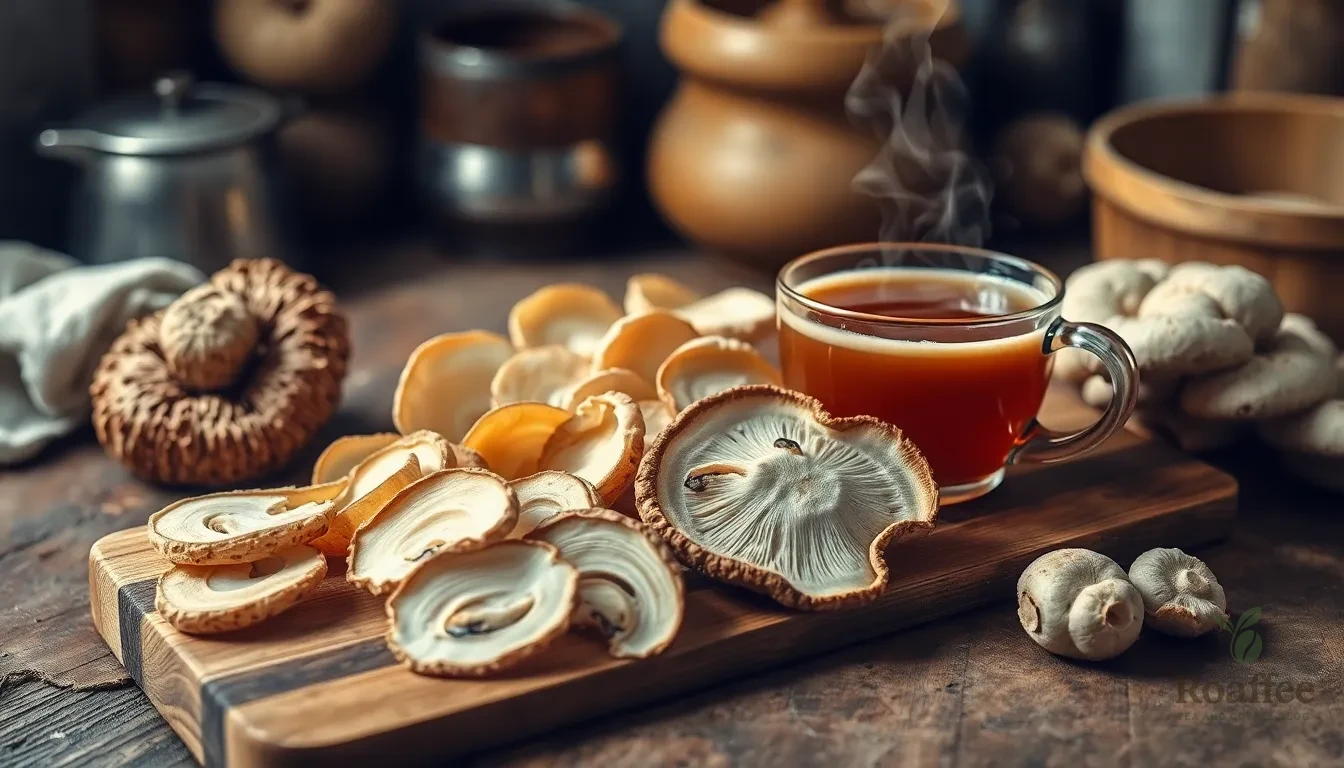
We’ll walk you through the simple process of brewing medicinal mushroom tea using a traditional simmering method. This technique extracts maximum nutrients and creates a flavorful therapeutic beverage.
Prep the Mushrooms
We begin by preparing our mushrooms properly for optimal extraction. Fresh mushrooms like shiitake, oyster, or lion’s mane should be cleaned thoroughly with a damp cloth or brush, then sliced thinly to increase surface area. Dried mushrooms require breaking into small pieces or grinding into a coarse powder using a coffee grinder for better steeping efficiency.
Fresh mushroom preparation:
- Clean with damp cloth or brush
- Slice thinly (about 1/4 inch thick)
- Use 25 ounces of fresh mushrooms per batch
Dried mushroom preparation:
- Break into small pieces or grind coarsely
- Use 1 to 3 ounces of dried mushrooms per batch
- Reishi mushrooms harden quickly when dried, so slice them immediately after harvesting
Simmer the Tea
We start by bringing 2 to 3 cups of water to a rolling boil in our saucepan. Once boiling, we reduce heat to maintain a gentle simmer and add our prepared mushrooms. The simmering process should last at least 20 to 30 minutes, though reishi tea benefits from longer extraction times up to 2 hours for maximum potency.
| Mushroom Type | Minimum Simmer Time | Maximum Simmer Time |
|---|---|---|
| Lion’s Mane | 20 minutes | 45 minutes |
| Shiitake | 20 minutes | 30 minutes |
| Reishi | 30 minutes | 2 hours |
| Turkey Tail | 25 minutes | 1 hour |
We stir occasionally during simmering to ensure even steeping. During the last 10 minutes of cooking, we can add flavor enhancers like fresh ginger, orange peel, cinnamon stick, or mint leaves to complement the earthy mushroom taste.
Strain and Serve
We remove the saucepan from heat and strain the tea through a fine mesh strainer or cheesecloth to remove all mushroom pieces. This step ensures a smooth drinking experience without any unwanted texture. The finished tea should be served hot for maximum enjoyment and therapeutic benefit.
We can enhance the flavor further by adding honey, lemon juice, or a splash of coconut oil to taste. The strained mushroom tea provides anti-inflammatory, antioxidant, and immune-supportive properties that have been valued in herbal medicine for centuries.
Directions for Different Mushroom Types
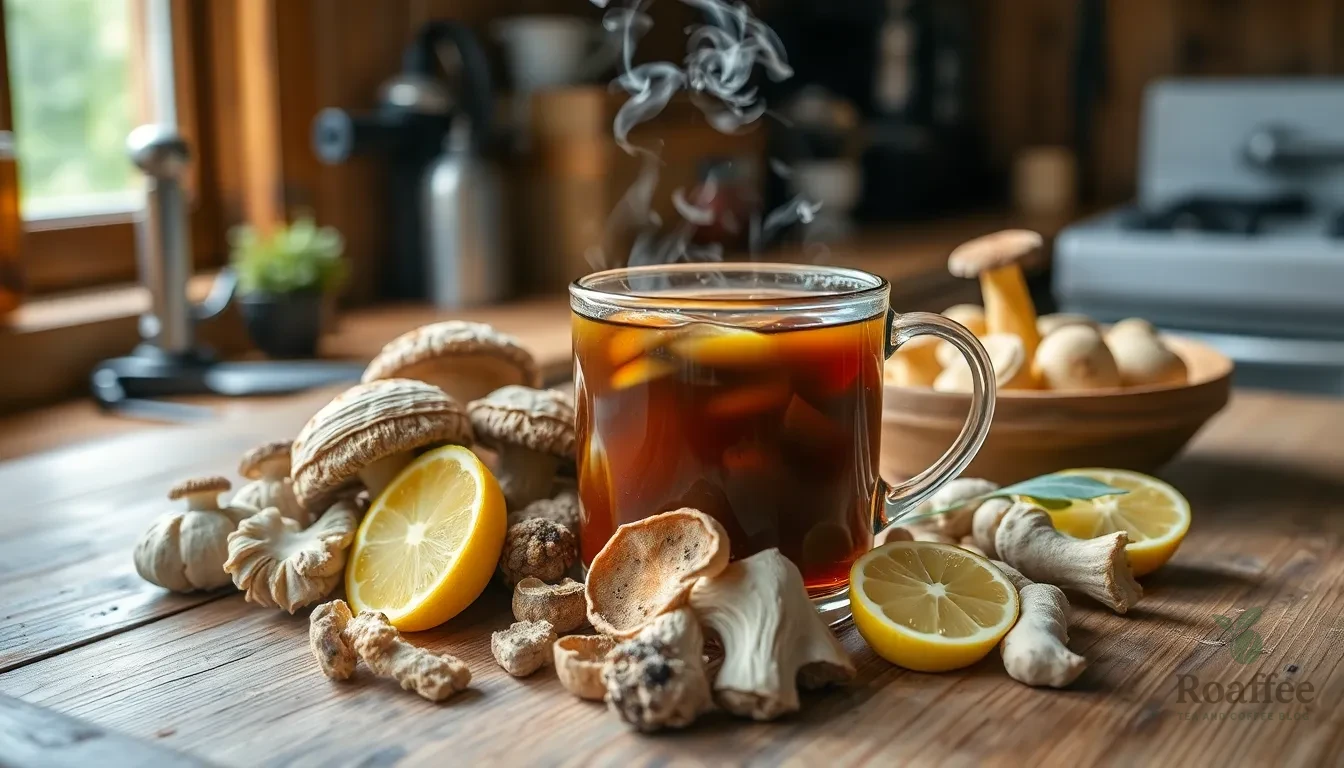
Each medicinal mushroom requires exact brewing techniques to unlock its full therapeutic potential. We’ll guide you through the optimal preparation methods for four popular mushroom varieties that deliver distinct health benefits.
Reishi Mushroom Tea
We start by bringing 1 cup of water or nut milk to a gentle boil for this adaptogenic powerhouse. Remove the liquid from heat and whisk in 1 teaspoon of reishi powder thoroughly to prevent clumping. For a richer flavor profile using dried reishi slices, we steep them directly in the hot liquid for 10-15 minutes.
The strong botanical and bitter notes of reishi respond well to flavor enhancers like fresh ginger slices, raw honey, or pure maple syrup. We recommend adding these ingredients while the tea is still warm to help them dissolve completely.
For a concentrated reishi preparation, we simmer 20 grams of dried sliced reishi in 4 quarts of water for 1-2 hours until the liquid reduces to 1 quart. Store this concentrate in the refrigerator and dilute 1 cup concentrate with 4 cups of water when serving. Fresh lemon juice and honey balance the earthy intensity perfectly.
Chaga Mushroom Tea
We prepare chaga using a similar simmering method to reishi, though this antioxidant-rich mushroom benefits from longer extraction times. Break dried chaga chunks into smaller pieces or use pre-ground chaga powder for faster brewing.
Bring 4 cups of water to a boil and add 2-3 tablespoons of chaga pieces. We reduce heat to maintain a gentle simmer for 15-30 minutes, allowing the dark, coffee-like color to develop. The resulting tea delivers earthy flavors with subtle vanilla undertones.
We enhance chaga’s natural taste with fresh lemon juice and natural sweeteners. The citrus brightens the robust flavor while providing additional vitamin C to complement chaga’s immune-supporting properties.
Lion’s Mane Mushroom Tea
We brew lion’s mane using either extract powder or dried mushroom pieces for cognitive enhancement benefits. Heat 1 cup of water to just below boiling point, around 180-190°F, to preserve the delicate compounds.
Add 1 teaspoon of lion’s mane powder or 1 tablespoon of dried pieces to the hot water. We steep for 5-10 minutes, covering the cup to retain heat and prevent evaporation of volatile compounds.
Lion’s mane blends exceptionally well with other mushrooms like reishi for a comprehensive wellness tea. We often combine it with calming ingredients such as chamomile, ground cinnamon, and maple syrup to create a soothing evening beverage that supports both cognitive function and relaxation.
Shiitake Mushroom Tea
We prepare shiitake tea using fresh or dried mushrooms, both delivering cardiovascular and vitality benefits. For fresh shiitake, we slice 3-4 medium mushrooms and add them to 2 cups of simmering water for 10-15 minutes.
Dried shiitake requires longer extraction time. We break 2-3 dried mushrooms into smaller pieces and simmer them in 2 cups of water for 20-25 minutes. The resulting tea develops a rich umami flavor with subtle smoky notes.
We serve shiitake tea alone for its pure flavor or blend it into mushroom tea combinations for enhanced nutritional benefits. The mild taste makes it an excellent base for adding stronger flavored mushrooms like reishi or chaga.
Flavor Variations
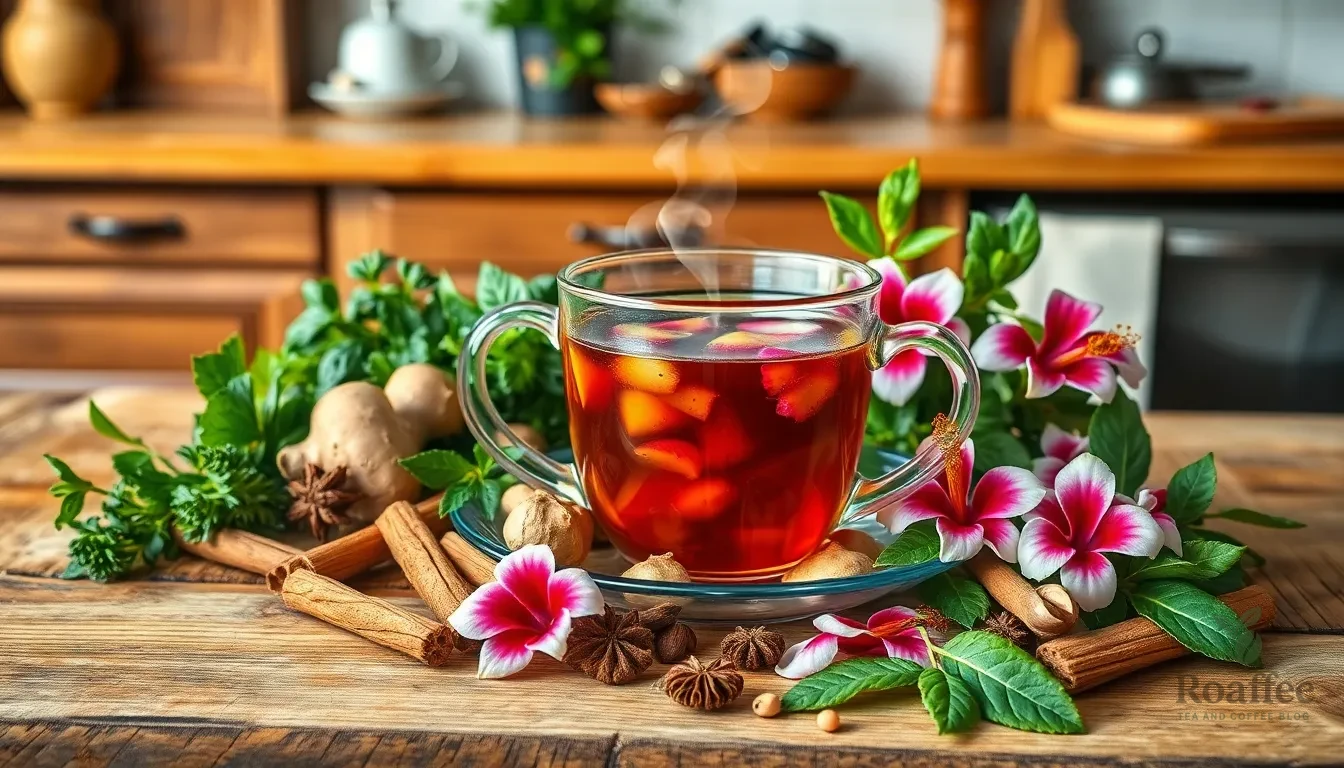
We can transform basic mushroom tea into a complex and delicious beverage by incorporating various herbs, spices, and natural sweeteners. Each addition serves a dual purpose: masking the earthy undertones while improving the therapeutic benefits of our mushroom tea.
Herbal Additions
Herbal blends create the perfect foundation for balancing mushroom tea’s natural earthiness. We recommend combining hibiscus, licorice, chai, and green tea to create a well-rounded flavor profile that masks any bitter notes. Fresh ginger adds warmth and digestive benefits while brightening the overall taste. Lemon juice provides essential vitamin C and cuts through the mushroom’s density with its citrusy tang. Yarrow tea introduces subtle floral notes that complement the earthy mushroom base beautifully.
Green tea deserves special attention as a base for mushroom tea variations. Japanese green teas contribute sweetness and delicate vegetal notes that pair exceptionally well with maitake or shiitake mushrooms. Chinese green teas offer bolder, more robust flavors that can stand up to stronger mushroom varieties like reishi or chaga.
Spice Blends
Warming spices elevate mushroom tea from simple to sophisticated. We find that cinnamon, black pepper, and cayenne pepper create an ideal spice foundation that adds both warmth and complexity. These spices work particularly well with the woody notes found in reishi and chaga mushrooms.
Chai spices transform mushroom tea into a comforting beverage perfect for cold weather. Cardamom, cloves, and cinnamon enhance the earthy mushroom flavors while creating a familiar and inviting taste profile. This combination works especially well with lion’s mane mushrooms, which have a naturally light and slightly savory flavor.
Sweetening Options
Natural sweeteners provide the perfect finishing touch to our mushroom tea creations. Honey offers antimicrobial properties while adding floral sweetness that complements the herbal additions. Maple syrup brings rich, complex sweetness with subtle caramel notes that pair beautifully with chai spices.
Vanilla extract or vanilla bean pods introduce creamy sweetness without overwhelming the delicate mushroom flavors. We particularly enjoy vanilla with maitake mushrooms and green tea combinations. Sweet flowers like honeysuckle add delicate floral notes and natural sweetness that creates an elegant finishing touch to any mushroom tea blend.
Storage Instructions
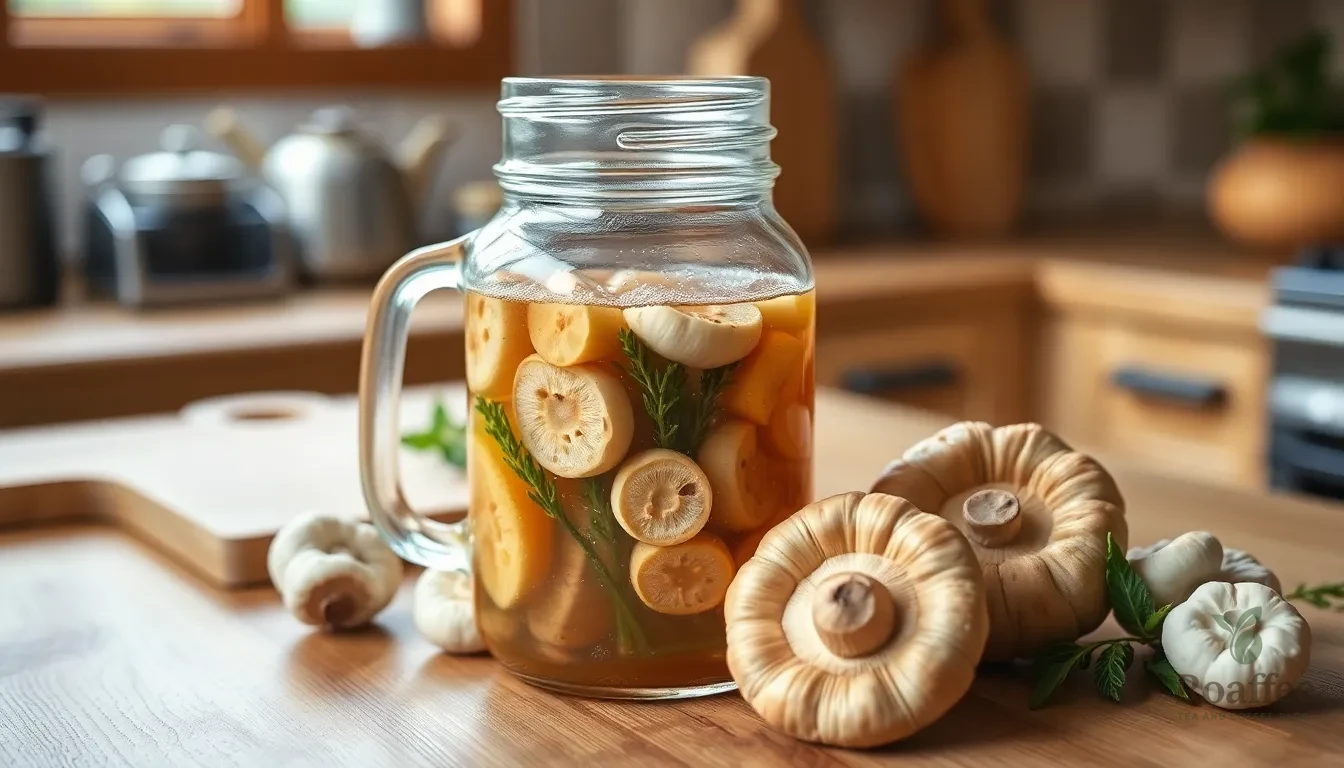
We recommend storing your freshly brewed mushroom tea in a sealed glass container such as a mason jar to maintain its potency and prevent contamination. Glass containers preserve the tea’s beneficial compounds better than plastic alternatives while providing an airtight seal that keeps harmful bacteria at bay.
Refrigeration is essential for maintaining the quality and safety of your mushroom tea. We store our prepared tea in the refrigerator immediately after it cools to room temperature. Your mushroom tea will remain fresh and safe to consume for 3-7 days when properly refrigerated.
| Storage Method | Duration | Temperature |
|---|---|---|
| Refrigerated in glass container | 3-7 days | 35-40°F |
| Frozen for extended storage | Up to 3 months | 0°F |
| Room temperature | Not recommended | Unsafe after 2 hours |
Reheating options give you flexibility in how you enjoy your stored mushroom tea. We reheat our tea gently on the stovetop using low heat to preserve the delicate compounds or simply enjoy it cold straight from the refrigerator. Both methods maintain the tea’s therapeutic properties while offering different taste experiences.
Freezing provides long-term storage when you’ve prepared large batches of mushroom tea. We pour cooled tea into ice cube trays or freezer-safe containers leaving room for expansion. This method allows you to thaw individual portions as needed without waste.
Daily equipment sanitization ensures the safety and quality of your mushroom tea storage. We wash all brewing equipment including teapots, utensils, spigots, and storage containers with hot water and detergent after each use. A thorough rinse followed by sanitization using 170°F water for 1 minute or a sanitizing solution for 5 minutes eliminates harmful bacteria and maintains food safety standards.
Signs of spoilage include off odors, cloudy appearance, or unusual taste that differs from your freshly brewed tea. We discard any mushroom tea showing these signs to avoid potential health risks and maintain our commitment to safe consumption practices.
Make-Ahead Tips
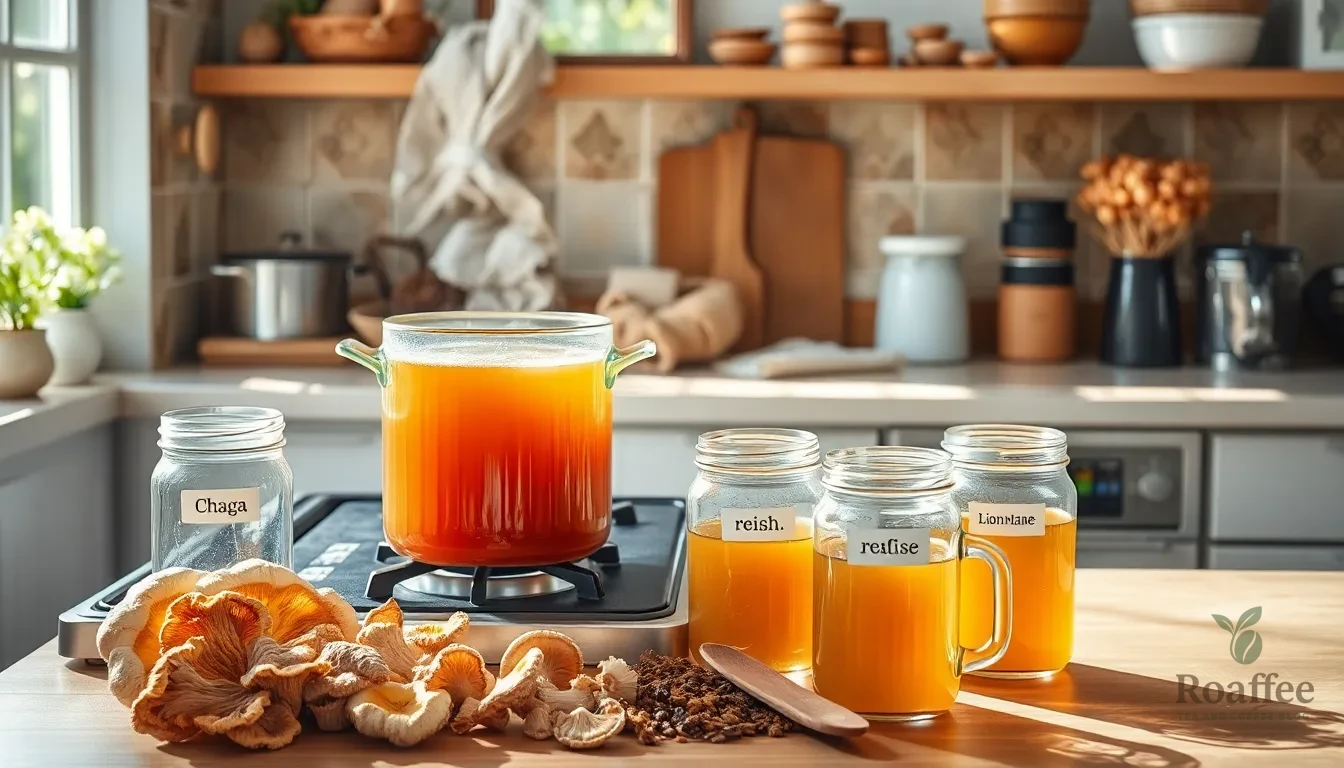
Preparing mushroom tea in advance saves time and ensures you always have this therapeutic beverage ready for your wellness routine. We recommend brewing larger batches to maximize efficiency while maintaining the potent health benefits of your chosen mushrooms.
Batch Brewing for Maximum Efficiency
Start with a large pot or slow cooker when preparing multiple servings at once. We suggest brewing 8 cups of water with your desired mushroom variety to create a concentrated base that can be diluted later. This method works particularly well with chaga and reishi mushrooms since they release their beneficial compounds slowly over extended steeping periods.
| Mushroom Type | Batch Size | Steeping Time | Reuse Potential |
|---|---|---|---|
| Chaga | 8 cups water with ½ ounce dried chaga | 30 minutes | 2-4 additional brews |
| Reishi | 6 cups water with 2 tablespoons powder | 15-20 minutes | Single use |
| Lion’s Mane | 4 cups water with 3 tablespoons dried | 10-15 minutes | Single use |
| Turkey Tail | 8 cups water with 1 ounce dried | 20-30 minutes | 2-3 additional brews |
Maximizing Mushroom Reuse
Chaga chunks offer exceptional value since they can be reused for multiple brewing sessions. Store your used chaga pieces in a sealed glass jar in the refrigerator between brewing sessions. We find that chaga maintains its potency for 2-4 additional infusions when properly stored.
Turkey tail mushrooms also provide good reuse potential. Save the strained mushroom pieces after your first brew and store them refrigerated for up to one week. The second and third brews will be milder but still contain valuable compounds.
Storage Answers for Prepared Tea
Transfer your freshly brewed mushroom tea to clean glass containers once it has cooled to room temperature. We recommend using mason jars or glass pitchers with tight fitting lids to prevent contamination and preserve flavor integrity.
Label each container with the mushroom type and brewing date to track freshness. Properly stored mushroom tea maintains its quality in the refrigerator for 3-7 days depending on the variety used.
Freezing for Long Term Storage
Ice cube trays provide an excellent method for portion control when freezing mushroom tea. Pour cooled tea into ice cube trays and freeze until solid. Transfer the frozen cubes to freezer bags labeled with contents and date.
These frozen tea cubes can be added directly to hot water for instant mushroom tea or used in smoothies for added nutrition. Frozen mushroom tea maintains its beneficial properties for up to 3 months when stored properly.
Quick Serving Preparation
Keep concentrated mushroom tea on hand for quick preparation throughout the week. Brew a strong base using double the normal amount of mushrooms then dilute with hot water when ready to serve.
Add your preferred flavor enhancers like honey, lemon juice, or ginger after reheating to maintain their potency and fresh taste. This approach allows you to customize each cup while having the foundational mushroom brew ready instantly.
Serving Suggestions
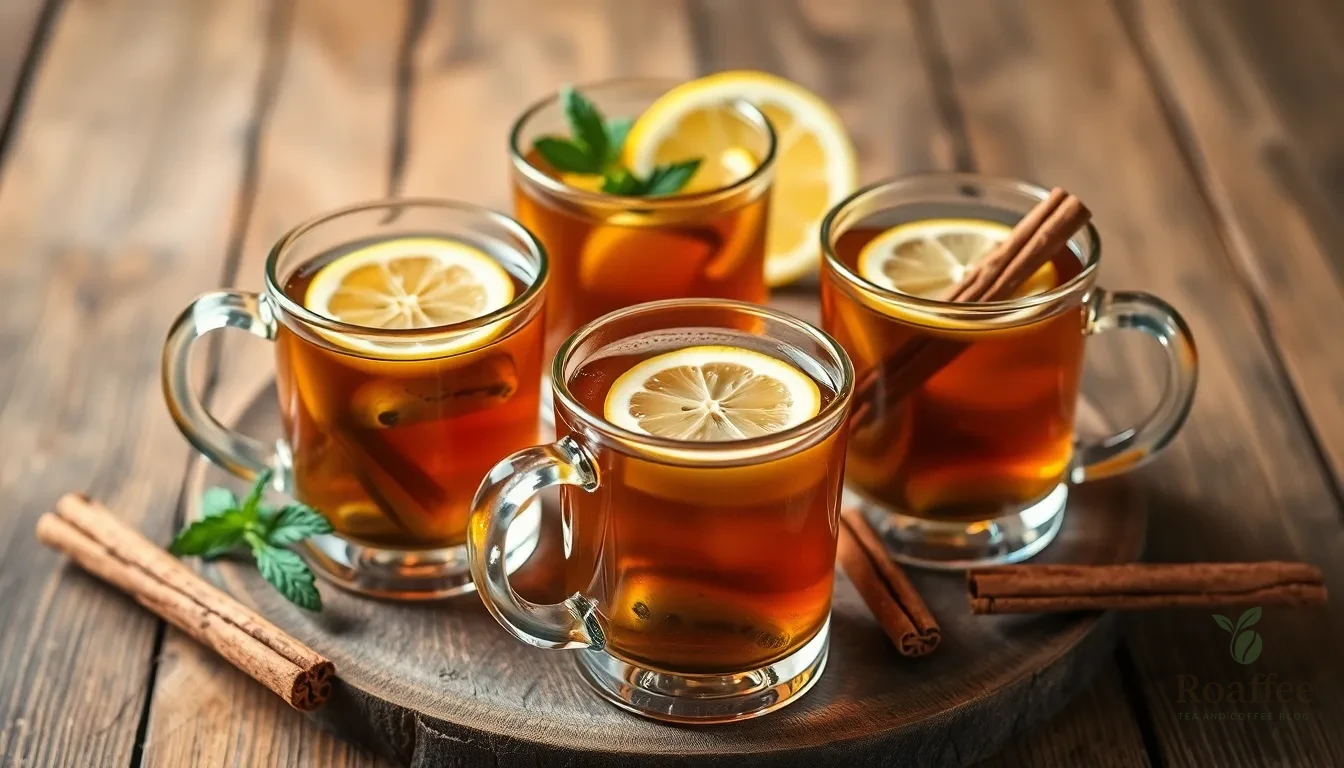
We recommend serving mushroom tea warm in your favorite mugs to fully appreciate the earthy flavors and aromatic compounds. Traditional ceramic or glass mugs work best for maintaining optimal temperature while allowing you to enjoy the tea’s natural color and steam.
Classic Warm Presentations
Fresh lemon slices make an excellent garnish that brightens the earthy mushroom flavors while adding vitamin C to your wellness routine. We suggest floating a thin lemon wheel on top of each serving or providing lemon wedges on the side for individual customization. A light sprinkle of ground cinnamon creates visual appeal and adds warming spice notes that complement the mushroom’s natural umami profile.
Creamy Texture Enhancements
Frothed milk transforms basic mushroom tea into a luxurious café-style beverage that feels indulgent while maintaining health benefits. We recommend using a milk frother or French press to create silky foam from your preferred milk type. Coconut milk offers a dairy-free alternative that adds tropical richness and healthy fats that support nutrient absorption.
Natural Sweetening Options
Honey provides the most traditional sweetening method that pairs beautifully with mushroom tea’s earthy undertones. We suggest starting with one teaspoon per cup and adjusting to taste preferences. Maple syrup offers a deeper sweetness with mineral content that enhances the tea’s wellness profile. Agave nectar works well for those seeking a lower glycemic option that dissolves easily in hot liquids.
Refreshing Cold Variations
Mushroom tea mocktails create an innovative way to enjoy these functional beverages during warmer weather or social gatherings. We recommend blending cooled mushroom tea with fresh lime juice and natural sweeteners over ice for a refreshing twist. This preparation method maintains the beneficial compounds while offering a completely different flavor experience.
Presentation Enhancement Tips
Serving mushroom tea in clear glass mugs allows guests to appreciate the tea’s natural golden or amber hues depending on the mushroom varieties used. We suggest garnishing each cup with a cinnamon stick that doubles as a stirrer and aromatic element. Fresh mint leaves provide a cooling contrast that balances the warming mushroom flavors while adding visual appeal to each serving.
Conclusion
Creating the perfect mushroom tea doesn’t require complicated techniques or expensive equipment. With our comprehensive guide you now have everything needed to brew therapeutic mushroom teas that support your wellness journey while delivering exceptional flavor.
Whether you’re seeking the calming effects of reishi the cognitive benefits of lion’s mane or the immune support of chaga each cup offers unique health advantages. The beauty of mushroom tea lies in its adaptability—experiment with different flavor combinations storage methods and serving styles to find what works best for your lifestyle.
We encourage you to start with one mushroom variety and gradually expand your collection as you discover your preferences. Remember that consistency is key to experiencing the full benefits so make mushroom tea a regular part of your daily routine and enjoy this ancient wellness practice in your modern life.
Frequently Asked Questions
What is mushroom tea and why is it popular?
Mushroom tea is an ancient wellness beverage made from medicinal mushrooms like reishi, lion’s mane, and shiitake. It’s gaining popularity as a modern superfood because each mushroom type offers unique health benefits including relaxation, cognitive support, and immune boosting properties that have been valued in herbal medicine for centuries.
Which mushrooms are best for making tea?
The best mushrooms for tea include fresh varieties like shiitake, oyster, maitake, and lion’s mane, and dried options such as reishi, chaga, turkey tail, and cordyceps. Each type provides distinct therapeutic benefits – reishi for relaxation, lion’s mane for cognitive support, and shiitake for cardiovascular health.
What equipment do I need to brew mushroom tea?
Essential equipment includes a saucepan or kettle for boiling water, a fine mesh strainer or cheesecloth for removing solids, and a mug or teapot for serving. Optional tools include a coffee grinder for powdered mushrooms, a slow cooker for batch preparation, and a digital scale for precise measurements.
How do I brew mushroom tea properly?
Use a traditional simmering method for maximum nutrient extraction. Clean and slice fresh mushrooms or break dried ones into smaller pieces. Simmer for the recommended time based on mushroom type, then strain and serve. Add flavor enhancers like honey and lemon juice to taste.
How long does mushroom tea last and how should I store it?
Freshly brewed mushroom tea lasts 3-7 days when stored in sealed glass containers in the refrigerator. For long-term storage, freeze portions in ice cube trays. Always sanitize brewing equipment and watch for signs of spoilage like off-odors or mold growth.
What can I add to improve the taste of mushroom tea?
Enhance flavor with herbs like hibiscus or green tea, warming spices such as cinnamon and black pepper, and natural sweeteners like honey or maple syrup. These additions complement the earthy undertones while adding their own wellness benefits to your brew.
Can I make mushroom tea in advance?
Yes, you can prepare concentrated mushroom tea bases in larger batches. Store properly labeled containers in the refrigerator or freezer. Some mushrooms like chaga and reishi can be reused for multiple brews, making advance preparation both convenient and cost-effective.
How should I serve mushroom tea?
Serve warm in ceramic or glass mugs with classic garnishes like fresh lemon slices and cinnamon. For creamy texture, add frothed milk or coconut milk. Cold variations work well in warmer weather – try mushroom tea mocktails with lime juice and natural sweeteners.

